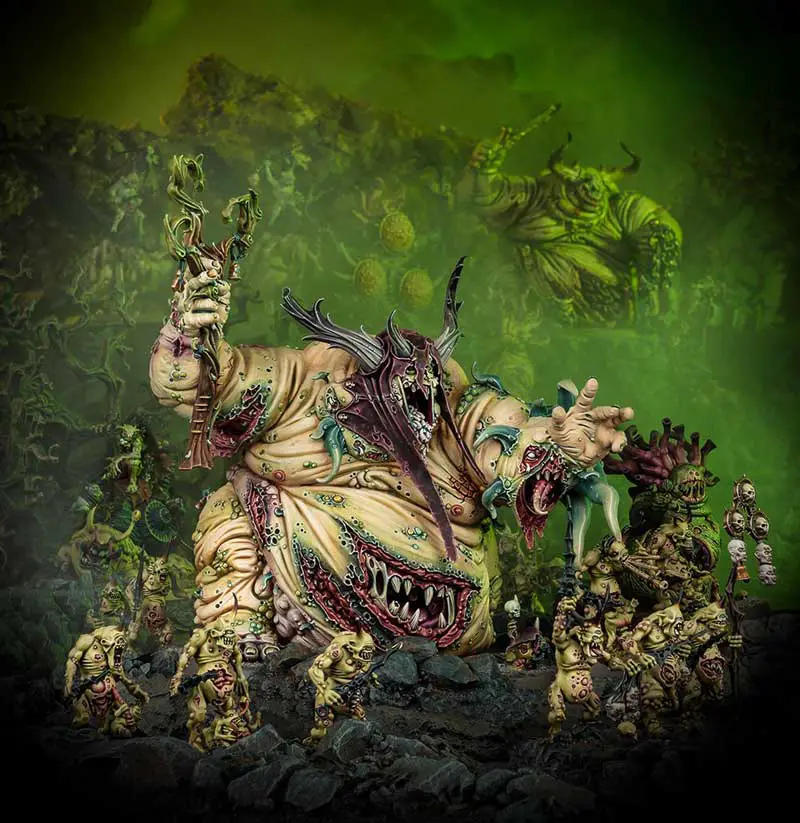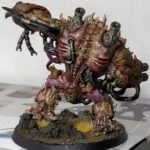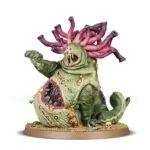Nurgle, the Plague Lord | Introduction to the Chaos God

In the Warp, a metaphysical realm where the psyche of all sapient races takes form lay many entities. The most powerful of them are the four Chaos Gods, referred to as Ruinous Powers.
The most repugnant of them is Nurgle, the Plague Father. This is only one of his titles, others being Lord of All, Plague Lord, Lord of Decay, Great Corruptor, and Fly Lord. All bearing the notions of his disgusting domains of disease, despair, and death.
Introduction to Nurgle
Nurgle is a chaos god in the Warhammer 40,000 universe. He embodies decay, disease, and despair, and is worshipped by those who embrace the inevitability of death and decay. His followers are characterized by their rotting bodies, and they seek to spread Nurgle’s gifts of disease and decay to all living things.
The Grandfather Nurgle is the jolliest out of the four Chaos Gods. Though he is associated with plague and death, Nurgle and all of his children are extremely cheerful. Even the most disgusting of the Plague Father’s kin is endlessly joyful.
The Domain of Nurgle: Decay and Disease
Nurgle’s domains include despair, decay, and disease. The power of these domains is such that Nurgle is sometimes referred to as the Lord of All. This moniker comes from the fact that all things eventually perish. Even the most long-lived things eventually meet their demise.
Of course, the diseased part is more prominent in the setting and game. Nurgle cooks up new and nastier diseases within his cauldron. Spreading them throughout the galaxy with his minions. Those that fall ill to these horrible illnesses are prime recruits to Nurgle’s ranks.
As the suffering of their ailment escalates, the infected person will start seeking escape from their despair. Eventually turning to Nurgle who, graciously, alleviates physical pain. Even as the new worshippers twist and disgustingly mutate, they stay praising Nurgle. Having found a twisted sense of comfort in their desperate state.
The Importance of Nurgle in Warhammer 40k
Nurgle’s a god who represents life, death, and rebirth. These concepts are intricately tied into his domains. Even diseases of Nurgle carry the cycle of life within them. Not only does a person start to decay and approach their death, but they are also given the opportunity to be fully reborn with the disease.
Nurgle is opposed to another Chaos God, Tzeentch. As Tzeentch is a force of change while Nurgle represents stagnation. Their clashes manifested on every level of society.
The Lore of Nurgle
Chaos Gods are plentiful in background information. Their inception, behavior, and followers are numerous. Though in the end it’s impossible to fully understand or predict these entities, there are quite a few things that have been compiled both in and out of the universe of Warhammer 40k.
The Origins and History of Nurgle
The creation of Nurgle falls into one of two theories, depending on the lore we follow. One ties it closer to the ancient War in Heaven and the other to the timeline of human development.
War in Heaven was a conflict that included the race of Necrontyr, who later became Necrons, as they faced off against Old Ones, a highly advanced and currently extinct psychic race. This was one of the biggest wars the galaxy has ever known, pulling all sorts of minor factions into the fold.
The war has generated a ton of disturbance in the Warp, the spiritual realm that reflects reality. Death, war, and all that comes with accumulated in the Warp. Giving birth to three of the four Chaos Gods. One of them was Nurgle, who was invigorated by the stagnancy of the universe.
The second tale of Nurgle’s inception talks of the entity forming during the time of plagues on Earth, around the Dark Ages. That may not be why Nurgle was born but merely a ripple of the Chaos God fully forming, though it’s the way the birth is noted.
Nurgle’s Beliefs
The beliefs of Nurgle are ones of entropy. Though Chaos often represents entropic forces, Nurgle is the most potent among them. Followers of Nurgle embody this entropy in both their practices and behaviors.
Nurgle’s followers affect the political machinations of worlds too. Opposing Tzeentch by making all the change-driven and ambitious strides stagnate. The followers of Nurgle propose conservationism and stagnation in the political scene, halting the change.
After all, stagnation is what Nurgle wishes. Through stagnation, all things entropy, and through entropy, they are delivered right into the loving embrace of Nurgle.
Nurgle’s Mythology
It is said that Nurgle resides in the Garden of Nurgle. A realm within the Warp that is home to all afflictions of the known universe. Though one would expect such a realm to be barren, devastated by despair, and commanded by death, the Garden of Nurgle is anything but.
The garden is thick with life. Though most of that life is a mere touch away from killing a regular person, it is quite lively nonetheless. Flies buzz, vines and fungi flourish, muddy waters dot the lands, and canopies stretch as wide as they would in material forests.
Far within the garden, sits Nurgle with his cauldron. Forever brewing new diseases. The only company he has is Isha, the Eldar goddess of healing. Nurgle has her imprisoned within the garden as she acts as a great subject to test out his diseases. She can heal from any ailment, the speed of her healing dictating whether Nurgle is satisfied with the disease or not.
While Plague Father toils on another plague, Isha whispers the solutions to these ailments into the pox. She is believed to be the source of all cures just as Nurgle is the source of all diseases.
His sacred number is seven. This number is found within all the possible organizations of Nurgle. Including names of cults and organizations that his followers organize.
Nurgle’s Powers
Unlike other Chaos Gods, Nurgle merges a lot of his powers and behaviors into diseases. Due to the intricate connection with stagnation and capitalizing on despair, it makes his boons and banes harder to distinguish.
Nurgle’s Boons, Curses, and Daemonic Afflictions
Boons, curses, and afflictions of Nurgle are often interchangeable. All of these are expressed in various diseases the Plague Father concocts in his cauldron. These twist the form of those afflicted, as bulbous growths appear and insides spill out in unnatural ways.
Without the favor of Nurgle, the sick will suffer immensely. With so many possible ailments, the variety of despair is plentiful. Among these plagues, the foulest and most known is Nurgle’s Rot.
Nurgle’s Rot is the most contagious and wicked ailment. It is the greatest of Nurgle’s creations and has been the standard he holds all of his latter plagues to.
The Nurgle’s Rot slowly bloats the body of the sick, makes their eyes merge into a single one, and a horn grows out of their head. The body isn’t the only one to suffer, the soul of the afflicted too.
There are two paths for the Nurgle’s Rot victims: they either take their own life to shorten the suffering or accept Nurgle. Accepting Nurgle will allow them to be reborn as Plaguebearer in Grandfather’s garden.
The Daemons of Nurgle
Repugnant beyond belief, Nurgle’s daemons laugh and prance across the battlefields. Their victims often dying more out of blissful abandon the daemons exhibit than killing intent.
Plaguebearer
As noted before, all Daemons of Nurgle are quite cheerful. However, they need some organizing which is where Plaguebearers come in. Though lesser demons in classifications, Plaguebearers are the ones most obsessed with organization. Their role, in and out of combat, is to count through the plagues of Nurgle within both Warp and the Material World.
These daemons thus provide a more focused group among the truly chaotic of their kin. Chanting monotonous hymns that tally the diseases in the known universe, hence why they are occasionally referred to as Tallymen of Nurgle.
Nurglings
Nurglings are the “cutest” of the Nurgle’s hosts. They are pus and contagion incarnate, looking like Nurgle himself. However, they are tiny and often move around in huge groups. Nurglings orbit greater daemons of Nurgle feeding on its pungent expulsions. So too do Nurglings flock around Death Guard at times, feeding on the flaking flesh of the traitor marines.
Other Daemons of Nurgle
Nurgle has a ton of odd beings in his repertoire. All ready for cheerful spread of plagues:
- Rot Flies: huge flying beasts, often used as mounts
- Molluscoid: massive snail-like daemons that serve as mounts
- Bloat Flies: small daemonic familiars
- Feculent Gnarlmaws: Endemic to garden of Nurgle, plant-like monstrosities with huge maws
Nurgle’s Followers
All of the fetid and pus-filled glory of Nurgle makes Plague Father popular across the galaxy. Well, either that or the numbing of the searing pain felt from the maladies he inflicts.
Nurgle’s Mortal Champions: The Death Guard Legion
The legion which corresponds to Nurgle’s worship is the Death Guard. This traitor marines legion wasn’t always known as such. In their inception, they bore the name Dusk Raiders. The origin of that name is based on the tactics of Albia, a Terran region where their gene-seed was sourced from.
However, Dusk Raiders are no more. The Death Guard is a name taken on after they were reunited with their primarch, Mortarion. Mortarion dubbed them his unbroken blades and donned the name onto the legion.
The fall to Nurgle happened when Typhon, referred to as Typhus after corruption, led Mortarion and his marines into a trap. Trapping the legion in the warp and suffer endless plague upon them. Mortarion too was eventually broken by the plague and accepted allegiance with Nurgle.
The Death Guard were reborn as Plague Marines, pus-filled and infested transhumans with incredible resilience. Their bodies are twisted by the diseases they harbor, Plague Marines are among the most disgusting of the traitor marines.
Aside from durability, these marines are known to spread diseases through touch alone, including the devastating Nurgle’s Rot. Any encounter with these traitors is bound to be devastating.
The role of the legion has become to spread disease and devastation. Not only for the sake of the Plague Father but for their own pitiful reasons. Through these actions, they hope to make their failure and fall seem lesser in the eyes of the cosmos.
Other Nurgle Forces
Aside from the Chaos Space Marines aligned with Nurgle, there are other representatives of the Plague Father across the galaxy. These range from his own kin to mundane mortals singing praises to the Fly Lord.
Great Unclean ones
Great Unclean Ones are the Greater Daemons of Nurgle. Their harrowing appearance is a reflection of the Chaos God they serve. Covered in sores, boils, with intestines hanging out from every diseased wound, these daemons are horrible to behold.
Unlike their appearance, the character of the Great Unclean ones is quite joyful and even friendly. At least towards the kin of Nurgle, whom these daemons encourage and compliment for all of their horrible achievements. Any competition between the Great Unclean Ones stems from friendly rivalry rather than notorious one-upmanship.
Beasts of Nurgle
Encompassing the joy of Nurgle the best are Beasts of Nurgle. They are joyful, big, and slug-like creatures that look for friends on the battlefield. Beasts of Nurgle are the pure joy of the Plague Father incarnate, always seeking pals despite the gruesome end it will lead to.
Though friendly they aren’t harmless. Beasts of Nurgle spread all sorts of noxious gasses and diseases as they slither throughout the field. Though if that doesn’t kill their “friend” a tight, poisonous hug will.
Nurgle Cults
The cults of Nurgle are numerous. Owing to the unorthodox way they may form, spawning from a pandemic or infection into a whole religion:
- 14th Volpone Bluebloods
- Children of the Merciful Lord
- Cult of Amber
- The Stigmatus Convent
- Tattered Veil
- Vile Savants
- Withering Stem
- Writhing World Sorcerer Kings
- Plaguechildren
- Tri-fold Scourge
- Plaguebrewer
- Poxpriest
- Hazakh Plaguetakers
Nurgle’s Influence in Other Factions
As you can imagine, the spread of plagues that Nurgle conducts helps to garner more followers. These can be found in the ranks of Space Marines, regular populace, Imperial Guard, and any who would be tormented enough by horrible maladies:
Nurgle:
- Apostles of Contagion
- Bilious Ones
- Bringers of Putrid Salvation
- Brotherhood of Reaping
- Carrion Hounds
Daemons:
- Plague Guard
- Septicus Legion
Traitor Knights:
- House Drear
- House Slughorn
- Rusthounds
Traitor Titans:
- Legio Onerus
- Legio Pestis
- Legio Morbus
- Festering Death
Nurgle in Gameplay
The Chaos Daemons faction accommodates all Chaos Gods. With the simple choice of allegiance, the army can be dedicated to a single God. Additionally, the dedicated Chaos Space Marines can also be counted as part of Chaos God’s armies. All of them contribute to a certain playstyle.
Nurgle’s Strengths and Weaknesses
Nurgle armies are tough beyond belief. The potency comes from the unnatural resilience of the troops. High toughness stat goes a long way to reinforcing Nurgle’s underlings. All of your troops will deal a lot more damage too, simply due to the extra staying power they have.
Diseases of Nurgle will weaken the foes before armies beat them down. Many of these are present in their rules. Contagion of Nurgle lowers toughness, deadly pathogens augment weaponry, and certain units manifest their own illnesses into the battleground.
Any army of Nurgle is bound to experience a few hiccups. The biggest of which is their speed. Nurgle armies are exceptionally slow. With very few units that can cover the field quickly. The infantry especially suffers from this problem. Additionally, the lack of good psykers makes it so the opponent’s psykers won’t be interrupted.
Nurgle in Different Game Modes
The matched play sees Nurgle struggle somewhat. Even with Death Guard entering the fray, it’s going to be a rough match with the loss of FNP rule in Nurgle daemons. They can still do some work but are among the worst of the lot in daemon armies.
Narrative play with Nurgle is always fun. You can come up with all sorts of hilarious fluff for your army and bring some levity to your table. If you are playing a premade narrative scenario, it’s still a generally fun time.
Open play is a bit keener on Nurgle. Due to people being a lot more fun-oriented in this style of play, Nurgle can do better. Without some of the meta staples, all of your diseased children will do better.
Nurgle Units and Strategies
Making a Nurgle army will always result in rows of tough units. Though their potency in dealing damage varies. Thankfully, Death Guard provides an ever-useful firing line. In fact, it’s these traitor space marines that make the Nurgle armies work.
The units in Nurgle’s armies have some rather interesting units. Their use being varied despite slowness of the army:
- Plague Marines (if Death Guard)
- Beasts of Nurgle
- Nurglings
- Soul Grinder
Tactics for victory include stumbling towards objectives while tanking hits and dishing out your own. In truth, aside from Death Guard, Nurgle daemons have a tough time dealing damage on their lonesome. So keep this in mind if running them solo.
Play for objectives, not for kills. It’s tough to get Nurgle off of points but pay note to your secondary objectives too. Pick those that you feel safe in achieving. Taking actions on objectives usually works best, as melee daemons get some use in the first round.
Conclusion
Nurgle is the most disgusting of the Chaos Gods. Others incorporate many horrible practices but it’s only Nurgle who revels in all that is disgusting. However, despite each depiction of these daemons being despicable, it’s hard to deny that their cheerful disposition does make them somewhat adorable. Regardless, as cute as they are, Nurgle and his children chart a morbid set of domains and behaviors.
*Image Source





